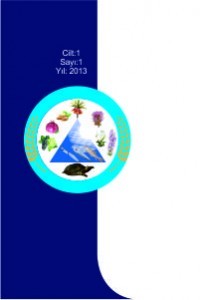SSR Markörlerinin Mercimek Genom Haritalamasında Kullanılması
Mercimek, Moleküler Markör, SSR Basit Dizi Tekrarları, RIL Rekombinant
Lentil Molecular Marker, SSR Simple Sequence Repeats, RIL Recombinant inbreed line, Linkage Map,
___
- Kumar, S., Hamwieh, A., Manickavelu, A., Kumar, J., Sharma, T., R., And Baum, M. 2014. Advances İn Lentil Genomics.6, 111 Springer Science Business Media
- Tanyolac, B., Ozatay, Ş., Kahraman, A., And Fred Muehlbauer. 2010. Linkage mapping of lentil (Lens culinaris L.) genome using recombinant inbred lines revealed by AFLP, ISSR, RAPD and some morphologic markers. Journal of Agricultural Biotechnology and Sustainable Development. 2(1 ); 001- 006
- Muehlbauer, F., J., Cho S, Sarker A, Ford R 2006. Application of modern technologies in lentil breeding for biotic and abiotic stress resistance. Euphytica 147:149–165
- Eujayl, I., Baum, M., Powell, W., Erskıne, W., And Pehu, E., 1998. A Genetic Linkage Map of Lentil (Lens sp.) Based on RAPD and AFLP Markers Using Recombinant Inbred Lines. Theor. Appl. Genet. 97: 83-89.
- Hamwıeh, A., Udupa, S. M., Choumane, W., Sarker, A., Dreyer, F., Jung, C., And Baum, M., 2005. A Genetic Linkage Map of Lens sp. Based on Microsatellite and AFLP Markers and the Localization of Fusarium Vascular Wilt Resistance. Theor. Appl. Genet. 110: 669-677.
- Rubeena, R., Taylor, W. J., Ford, P. And Ades, P. K., 2006. QTL Mapping of Resistance in Lentil (Lens culinaris ssp. culinaris) to Ascochyta Blight (Ascochyta lentis), Plant Breeding 125, 506-512.
- Havey, M. H., And Muehlbauer, F. J., 1989. Linkages Between Restriction Fragment Length, Isozyme and Morphological Markers in Lentil. Theor Appl Genet 77:395–401.
- Tahır, M., Erksıne, W., Hussaın, A., Baksh, A., Ellıs, R. H., Summerfıeld, R. J., And Roberts, E. H., 1993. Field Evaluation of a Model of Photothermal Flowering Responses in a World Lentil Collection. Theor. Appl. Genet 88: 423-428
- Tullu, A., Tar'an, B., Warkentın, T., And Vandenberg, A., 2008.Construction of an Intraspecific Linkage Map and QTL Analysis for Earlinessand Plant Height in Lentil. Crop Sci 48:2254-2264.
- Duran, Y., Fratını, R., Garcıa, P., And Vega, M. P., 2004. An Intersubspecific Genetic Map of Lens. Theor Appl Genet. 108: 1265-1273.
- Rajesh, P. N., Whıte, D., Saha, , G., Chen, W., And Muehlbauer, F.,2008. Development and genetic analysis of SSR markers in lentil. Plant &Animal Genomes XVI Conference, January 12-16, 2008, Town & Country Convention Center, San Diego, CA
- Hamwıeh, A., Udupa, S. M., Choumane, W., Sarker, A., Dreyer, F.,Jung, C., And Baum, M., 2005. A Genetic Linkage Map of Lens sp. Based on Microsatellite and AFLP Markers and the Localization of Fusarium Vascular Wilt Resistance. Theor. Appl. Genet. 110: 669-677.
- Kosambı D. D., 1944, The Estimation of map distances from recombination values, Eugene 12: 172-17 Kahraman, A., Kusmenoğlu, I., Aydın, N., Aydoğan, A., Erksıne, W. And Muehlbauer, F. J., 2004. QTL Mapping of Winter Hardiness Genes in Lentil, Crop Science, 13-22.5
- Phan, H., T., T., Ellwood, S., R., Hane, J., K., Ford, R., Materne, M., and Oliver, R., P. (2007) Extensive macrosynteny between Medicago truncatula and Lens culinaris ssp. Culinaris. Theoretical and Applied Genetics 114, 549–558.
- Verma, P.,Goyal, R., Chahota, R., K., Sharma, T., R., Abdin, M., Z., Bhatia, S. 2015.Construction of a Genetic Linkage Map and Identification of QTLs for Seed Weight and Seed Size Traits in Lentil (Lens culinaris Medik.). Plos One. 5;10 (10).
- Andeden, E., E., Baloch, F., S., Çakır, E., Toklu, F., Özkan, H. 2015. Development, characterization
- and mapping of microsatellite markers for lentil (Lens culinarisMedik.). Plant Breeding 134: 589- 598.
- Arumuganathan, K., Earle, E., D. 1991. Nuclear DNA content of some important plant .species. Plant Mol Biol Rep 9:208–218.
- Ates, D., Aldemir, S., Alsaleh, A., Erdogmus, S., Nemli, S., Kahriman, A., Ozkan, H., Vandenberg, A., Tanyolac, B. 2018. A consensus linkage map of lentil based on DArT markers from three RIL mapping populations. PLoS ONE 13(1): e0191375.
- Saha, G., C., Sarker, A., Chen, W., Vandemark, G., J., Muehlbauer, F., J., 2013. Inheritance and Linkage Map Positions of GenesConferring Agromorphological Traits in Lens culinaris Medik. Int J Agron 618926, 9 pages
- Hendre, P., S., Aggarwal, R., K., 2007. DNA Markers: Development And Application For Genetic Improvement Of Coffee. In: Varshney RK, Tuberosa R. (ed) Genomics-Assisted Crop Improvement. Springer, Dordrecht, p 399–434.
- Idrissi, O., Udupa, S.,M., Houasli, C., De Keyser, E., Van Damme, P., De Riek, J. 2015. Genetic diversity analysis of Moroccan lentil (Lens culinaris Medik.) landraces using simple sequence repeat and amplified fragment length polymorphisms reveals functional adaptation towards agro-environmental origins. Plant Breed 134, 322–332.
- Toklu, F., Karaköy, T., Hakle, I., Bicer, T., Brandolini, A., Kilian, B., Ozkan, H. 2009. Genetic variation among lentil (Lens culinaris Medik.) landraces from Southeast Turkey. Plant Breed. 128:178–186.
- Tsanakas, G., Mylona, P., Koura, K., Gleridou, A., Polidoros, A. 2018. Genetic diversity analysis of the Greek lentil (Lens culinaris) landrace ‘Eglouvis’ using morphological and molecular markers. Plant Genetic Resources: Characterization and Utilization 1-9.
- Tanyolac, B., Ozatay, S., Kahraman, A., Muehlbauer, F. 2010. Linkage mapping of lentil (Lens culinaris L.) genome using recombinant inbred lines revealed by AFLP, ISSR, RAPD and some morphologic markers. J Agric Biotechnol Sustain Dev 2:001—006.
- ISSN: 2667-4092
- Yayın Aralığı: Yılda 2 Sayı
- Başlangıç: 2013
- Yayıncı: Adıyaman Üniversitesi
Huriye Gözde CEYLAN, Tuba DEMİR, Şükrü KURT
Keten Tohumu Ununun Tavuk Köfte Yapımında Kullanımı
Osman KILINÇÇEKER, Muzaffer KIRPIK
Evaluation of Effectiveness of Strawberry Marketing Organization in Mersin/Turkey1
Arzu SECER, Burak OZTORNACI, Faruk EKMEKSİZ
SSR Markörlerinin Mercimek Genom Haritalamasında Kullanılması
Abdullah KAHRAMAN, Ümran Akgün YILDIRIM, Melike BAKIR
Ekmeklik Un Kalite Parametreleri Arasındaki İlişkiler
